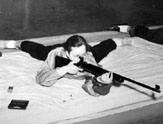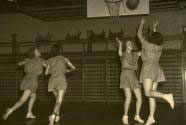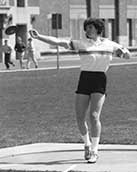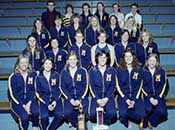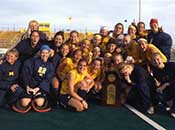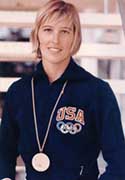A Sporting Chance: Women's Athletics at the University of Michigan
Physical Training - the Early Days
Twenty years after women were first admitted to the University of Michigan there were still few programs for women and no physical place on campus women could call their own. The Women's League began as an organization in 1890 but the building that now houses the League was not opened until 1929. Classes in physical education (first offered in 1894), the construction of Barbour Gymnasium for women (completed in 1898), and the organization of the Women's Athletic Association (WAA - 1905), along with the Women's League, answered the need for programs and places women could call their own.
Even more than an athletic facility, Barbour Gymnasium was the center for women's social events. The Women's Athletic Association and the Women's League encompassed all athletic, recreation, and social activities for women. The two most prestigious positions for women students were the presidencies of the League and of WAA.
(The quotes below, unless otherwise identified, are from Sheryl Szady, "The History of Intercollegiate Athletics for Women at the University of Michigan" PhD dissertation, UM 1987)
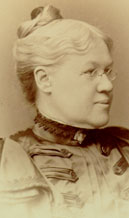
Dr. Eliza M. Mosher
In response to the concern regarding physical stamina, colleges and universities developed programs of "physical training" to monitor and promote the health of their women students. Michigan's President James B. Angell appointed Dr. Eliza M. Mosher, a physician and an 1875 Michigan Medical School graduate, as the first Dean of Women in 1896 to supervise the women students. Within her responsibilities were the provision for physical training of the women students, the monitoring of their health, and personal counseling. However women students had participated in organized physical activities prior to this appointment.
In 1893-94 the recreational sport activities for the women students were not organized: A University report noted that "The favorite amusements of the college girls are walking and tennis...There is no gymnasium as yet in operation... The walk around the campus, one mile in length, is also patronized by those in search of exercise."
"With the opening of the Waterman Gymnasium in the fall of 1894, physical training for women was offered during morning hours by an instructor of the men's gymnasium, Keene Fitzpatrick. The philosophy of the physical training program is evident from a statement about the new building: "In the conduct of the gymnasium the aim is not so much the development of a few gymnastic experts as the provision of wholesome physical exercise for the many.' -- U of M Catalog, 1894-1895."
"The classes consisted of muscular strengthening and improvement; exercises (known as "correctives") , basketball, and Swedish gymnastics... In 1897-98 the instruction included tennis, basketball, gymnastic games, and bicycling." Physical education remained compulsory for both men and women throughout most of the departments at the University until 1969.
Interclass and Intercollegiate Competition
"The inclusion of basketball in the physical training regimen was the first competitive team sport for women at the University of Michigan...The basketball game in the Open Day [exhibition games] of 1898 featured the freshman team playing the sophomore team for the University championship." Though called open, male spectators were allowed in by invitation only. The winner was to play Michigan State Normal College (now Eastern Michigan University) -- this is the first recorded intercollegiate match for a women's team.
Obeying the guidelines of the national association, the Athletic Conference of American College Women, Women's Athletic Association teams did not participate in intercollegiate competition before 1920. However, UM women joined local groups as individuals and competed with women from other colleges in this way. It was to be over fifty years before women's varsity teams were established.
For many years the University discouraged nationally sponsored competitions, "It will be our policy not to train individuals specifically for AAU meets. If individuals wish to enter Amateur Athletic Union (AAU) meets, the individuals should not be sponsored by the University of Michigan." (Department of Physical Education for Women report, 1955)
Give Me an "M"!
"Although women "lacked the incentive of the block M," other forms of recognition existed. A perpetual silver trophy cup was awarded to the University women's basketball champions of 1905... A schedule of athletic awards was adopted by the WAA in 1909.... in contrast to the varsity block M awarded to men for participation on intercollegiate teams, however, class numerals were awarded to women for competing on a class team in a similar matter to the men's program." It would take many more years for women to gain the right to win a Michigan "M" for their athletic achievements.
Traditions and Broken Barriers
Swimming, dance, golf, and gymnastics have long been offered to women students. Participation in other activities required the persistence of students and staff over many decades. "A men's rifle club was organized at Michigan for competitive purposes in 1907. When a woman entered the rifle range in December 1915 and proceeded to give an excellent exhibition of shooting skills, the men were amazed, dismayed, and hoped that she would not compete for a position on their team. She did not." But, a rifle class was offered to women in 1922 and women entered an intercollegiate challenge match later that year.
The Margaret Bell Years

The Director of the Department of Physical Education for Women (DPEW) for 34 years (1923-1957), Bell was also a University Health Service physician. She did not support varsity competition as she felt neither the students nor the equipment were prepared for it, "I think a girl should be a girl. The social position of women does not stand this exploitation and competition." (Bell quoted in Michigan Daily 10/19/24).
She also believed "that participation in varsity athletics could disrupt the functioning of the female reproductive system." This was a widely held theory, first espoused in the late nineteenth century but still affecting women's sports for decades afterward. (Margaret Bell, "The Doctor Discusses Basketball" quoted in Szady thesis)
Bell was a strong supporter of the Women's Athletic Association which continued to act as the "recreational arm" of the DPEW until 1957. She encouraged Women's League funding for the WAA, and intercollegiate "play days" of team competition, luncheon and tea. Throughout her tenure, Bell maintained that, "Michigan women have never felt the need for intercollegiate competition...adequate competition is provided at home in the intramural play between the dormitories, league houses and sororities..." (Bell, quoted in Szady thesis)
Marie Hartwig and an Era of Change
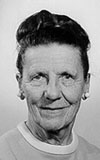
Hartwig had been with the DPEW since the 1930s and assumed leadership of the department's recreational programs with Margaret Bell's retirement in 1957. During her tenure, student interest in the WAA waned and there was increased pressure from students and faculty to allow greater extramural competition. At issue were funds for competition beyond the previous travel limit of four meets, no more than 75 miles distant, and the greater attractiveness of events sponsored by the AAU and other outside agencies. When sports at the University underwent an administrative shift in the late 1960s, the status of women's sports were left in a sort of limbo between true intercollegiate organization and reliance on a system of individual sports clubs. This often put U of M women, competing against teams with full varsity status at their school, at a disadvantage.
Show Me the Money!
Various means of supporting athletic programs for women included "tag days" in the "teens, sponsored by the Women's Athletic Association and the Women's League, and Lantern Day. The WAA did not depend on the DPEW for funding, though WAA expenditures required DPEW's approval. Sports funds were also "used to underwrite individual sport tea socials and publicity." (Szady thesis)
Serious attempts to increase University funding began in 1958. Even in the 1960s, women's athletics continued to be supported through such activities as the Michigras celebration, Cinema Guild income and sales of apples, calendars, golf and tennis balls, and riflery ammunition. By 1990, the number of varsity sports for women had grown to eleven, (gymnastics, softball, cross country, soccer, track, and golf were added, synchronized swimming was dropped) and total spending for women's athletics had increased from $100,000 to $2.4 million.
The Impact of Title IX
The turning point in the development of women's intercollegiate sports at the University came in 1972, when the United States Congress passed Title IX of the Education Amendment Act. Title IX banned sexual discrimination in education programs which received federal funding. In the realm of athletics, it required universities which received federal funding to provide equal athletic opportunities for men and women.
In the early 1970s, women athletes at Michigan had complained that the university distributed scholarships unfairly, provided women with less coaching time than men, allocated less travel money to women, and denied equal opportunities for the recruitment of women athletes. Forced to respond to both Title IX and the complaints, President Robben Fleming established the Committee to Study Intercollegiate Athletics for Women (chaired by Eunice Burns) in 1973 to investigate the development of women's intercollegiate (varsity) sports. Upon the recommendations of the Burns Committee's final report, the University established six varsity sports for women in the 1973/74 school year: tennis, basketball, swimming and diving, synchronized swimming, volleyball, and field hockey.
The new women's athletic program was placed under the administrative control of the Department of Intercollegiate Athletics and the Board in Control of Intercollegiate Athletics. Marie Hartwig was named the first women's athletic director.
From 1973 to 1981, women's sports at Michigan operated according to the rules of the Association of Intercollegiate Athletics for Women, a national organization that provided women's athletics with an alternative to the NCAA. Michigan's women's teams competed in two intercollegiate associations, one statewide and one regional.
The Phyllis Ocker Era
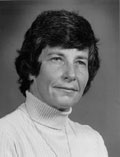
In 1977 Phyllis Ocker, former field hockey coach was named associate director of athletics for women's athletics. In 1981 women's varsity sports at the university came under the aegis of the NCAA, and began competing in the Big Ten conference. This was a controversial move as many women believed it decreased the amount of input women had in the administration and development of their varsity sports and represented a very different philosophy of women's sports than that of the AIAW.
The University's compliance with Title IX was slow, leading to the filing of additional complaints and to investigations by the Department of Health Education and Welfare in the late 1970s. These, in turn, led to an expansion of the women's program and an increase in financial support for women athletes, although it was not until 1989 that the University fully complied with Title IX in the area of scholarships.
Peggy Bradley-Doppes succeeded Ocker as associate director for women's sports and later helped integrate women's and men's sports into single administrative structure.
Adding Sports and Championships
Gymnastics, Golf, Softball and Track and Field were added to the varsity roster in 1977/78. Cross Country began varsity competition 1979/80. Synchronized swimming was dropped as a varsity sport when U-M women's athletics 1982 when U-M began competing in the Big Ten and NCAA (neither group sponsored the sport). After a long campaign, soccer was raised to varsity status in 1994/95, followed by rowing in 1996/97 and water polo in 2000/01. Lacrosse became the most recent varsity sport in 2013/14.The swimming team was the most successful of the original six sports, winning five MAIAW titles 1976-1980. Volleyball captured the Big Ten crown in 1981, the first of 161 conference titles for U-M women's teams. Three teams have won NCAA national titles: field hockey (2001), softball (2005) and gymnastics (2021). U-M's first individual national champion was Penny Neer, AIAW discus titleist in 1981. Mary Fischbach was first NCAA individual champion, winning the 1-meter and 3-meter diving titles in 1988. Michigan women have won 48 NCAA event championships (including relay events in swimming and track.)
Since the passage of Title IX and the establishment of the original six teams, more than 4,500 women have participated in varsity athletics at Michigan.

2021 gymnastics team
Michigan Women in the Olympics
A number of Michigan women from the pre-varsity era competed in the Olympics. Most of had competed at the club sport level and many had trained with Red Simmons' Micihigamme team. Among them were diver Micki King, Michigan's first female gold medalist (3-meters, 1972), and Francie Kraker, who later became U-M women's cross country and track coach. Swimmers Joan Spillane (1960) and Ginny Duenkel (1964) had won gold medals before enrolling at U-M. Since 1980, 41 varsity athletes have represented the United States, Canada, Britain, and seven other countries in Olympic competition. They have won five gold, eight silver, and four bronze medals.See Michigan in the Olympics for the full story Michigan's women Olympians.
More Sources for Women's Athletics History
Archival material at the Bentley Library
- Department of Physical Education for Women records [Finding Aid]
- Women's Athletics (University of Michigan), 1972-1990 [Finding Aid]
- Athletic Department (University of Michigan)records [Finding Aid] (covers women's athletics 1975 to present)
- Women's Athletic Association records, 1905-1962 [ Finding Aid]
- Marie Hartwig papers [Finding Aid]
- Joyce Lindeman papers [Finding Aid]
- Eunice Burns papers [Finding Aid]
Web Sites
- Athletic Department, M-GoBlue
- Bentley Library, UM Athletic History
- Persistence Pays Off: How Women Athletes Changed the Game at U-M (Panel discussion and interviews, presented as part of the 2014 LS& Theme Semester on Sport and Culture)
This site, created in cooperation with the University of Michigan Alumni Association, is maintained by the Bentley Historical Library.






